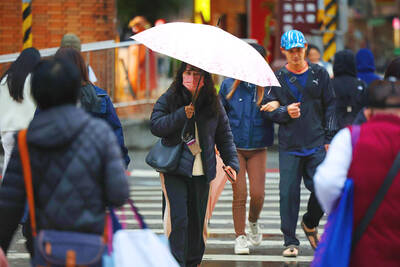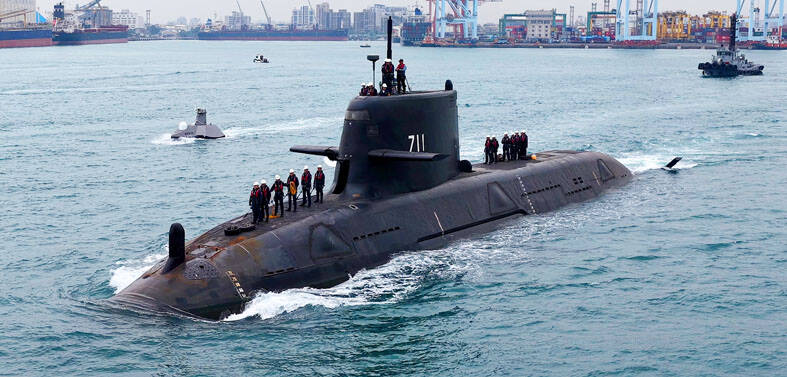A new study by researchers at the US National Defense University argues that Washington should defend Taiwan’s sea and air space and all of the first island chain nations in the case of a clash with China.
The strategy, known as “Offshore Control,” is described as an effective and affordable approach to a conventional conflict with China.
Published this week in National Interest magazine, it is written by distinguished research fellow T.X. Hammes and director of the Institute for National Strategic Studies R.D. Hooker.
The plan can assure US allies that Washington has the “will and capability” to prevail in a military confrontation and that their goal is to convince China that great-power rivalry is a poor choice, they say.
“Offshore Control establishes concentric rings that deny China the use of the sea inside the first island chain, defend the sea and air space of the first island chain nations, and dominate the air and maritime space outside the island chain,” the study says.
“Offshore Control does not strike into China but takes advantage of geography to block China’s key imports and exports and thus severely weaken its economy,” it says.
The study emphasizes that no kinetic operations would penetrate Chinese airspace and would thus reduce the possibility of nuclear escalation and make it easier to end the conflict.
This approach would exploit China’s military weaknesses, which increase exponentially beyond the first island chair that runs through the Japanese Archipelago, the Ryukyu Islands, Taiwan, the northern Philippines and Borneo to the Malay Peninsula, the study says.
“Allied naval and air forces attempting to operate near or on the Chinese territory face daunting odds,” it says.
“In contrast, allied forces fighting as part of an integrated air-sea-land defense of the first island chain gain major tactical advantages over Chinese forces,” it says. “Outside that arc, Chinese capabilities dwindle markedly.”
While the US could not stop all sea traffic in the zone, it could prevent the passage of large cargo ships and large tankers, severely disrupting China’s economy, according to the study.
As an integral part of denial, any Chinese military assets outside the Chinese 19km limit would be subject to attack.
“Numerous small islands from Japan to Taiwan to Luzon and on to the Straits of Malacca provide dispersed land-basing options for air and sea defense of the apparent gaps in the first island chain,” the study says.
“Since Offshore Control will rely heavily on land-based air and sea defenses, to include mine and countermine capability, we can encourage potential partners to invest in these capabilities and exercise together regularly in peacetime,” it says.
Hammes and Hooker said that the US would not request Taiwan or other nations to allow the use of their bases to attack China.
“The strategy will only ask nations to allow the presence of US defensive systems to help defend that nation’s air, sea and land space,” the study says.
“While such a concentric blockade campaign will require a layered effort from the straits to China’s coast, it will mostly be fought at a great distance from China,” the study says. “The only ways for China to break the blockade are to build a global sea-control navy or develop alternative land routes.”
“A sea-control navy will require investing hundred of billions of dollars over decades,” it says. “Alternative overland routes simply cannot move the 9.74 billion tons [8.8 billion metric tonnes] of goods China exported by sea in 2012.”
The authors believe a major conflict with China is “highly unlikely,” but if it should happen they say that the concept of “Air-Sea Battle” which has been strongly promoted would be both provocative and ineffective.
Under the “Air-Sea Battle” plan, US forces would attack Chinese surveillance systems and China’s integrated air defense system and bomb Chinese land-based ballistic and antiship missile systems.
Replacing the “Air-Sea Battle” plan with “Offshore Control” might convince Beijing that great-power cooperation can bring maximum benefit to China, the US and the rest of the world, the study says.

US climber Alex Honnold is to attempt to scale Taipei 101 without a rope and harness in a live Netflix special on Jan. 24, the streaming platform announced on Wednesday. Accounting for the time difference, the two-hour broadcast of Honnold’s climb, called Skyscraper Live, is to air on Jan. 23 in the US, Netflix said in a statement. Honnold, 40, was the first person ever to free solo climb the 900m El Capitan rock formation in Yosemite National Park — a feat that was recorded and later made into the 2018 documentary film Free Solo. Netflix previewed Skyscraper Live in October, after videos

NUMBERS IMBALANCE: More than 4 million Taiwanese have visited China this year, while only about half a million Chinese have visited here Beijing has yet to respond to Taiwan’s requests for negotiation over matters related to the recovery of cross-strait tourism, the Tourism Administration said yesterday. Taiwan’s tourism authority issued the statement after Chinese-language daily the China Times reported yesterday that the government’s policy of banning group tours to China does not stop Taiwanese from visiting the country. As of October, more than 4.2 million had traveled to China this year, exceeding last year. Beijing estimated the number of Taiwanese tourists in China could reach 4.5 million this year. By contrast, only 500,000 Chinese tourists are expected in Taiwan, the report said. The report

Temperatures are forecast to drop steadily as a continental cold air mass moves across Taiwan, with some areas also likely to see heavy rainfall, the Central Weather Administration (CWA) said. From today through early tomorrow, a cold air mass would keep temperatures low across central and northern Taiwan, and the eastern half of Taiwan proper, with isolated brief showers forecast along Keelung’s north coast, Taipei and New Taipei City’s mountainous areas and eastern Taiwan, it said. Lows of 11°C to 15°C are forecast in central and northern Taiwan, Yilan County, and the outlying Kinmen and Lienchiang (Matsu) counties, and 14°C to 17°C

STEERING FAILURE: The first boat of its class is experiencing teething issues as it readies for acceptance by the navy, according to a recent story about rudder failure The Hai Kun (海鯤), the nation’s first locally built submarine, allegedly suffered a total failure of stern hydraulic systems during the second round of sea acceptance trials on June 26, and sailors were forced to manually operate the X-rudder to turn the submarine and return to port, news Web site Mirror Daily reported yesterday. The report said that tugboats following the Hai Kun assisted the submarine in avoiding collisions with other ships due to the X-rudder malfunctioning. At the time of the report, the submarine had completed its trials and was scheduled to begin diving and surfacing tests in shallow areas. The X-rudder,